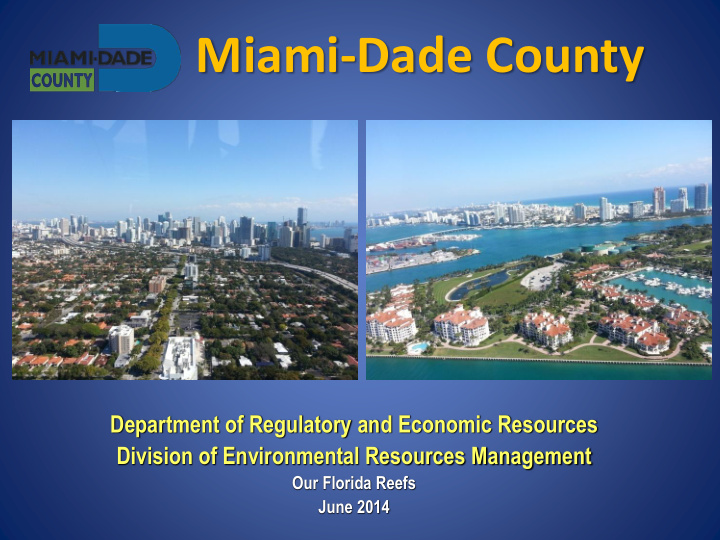



Miami-Dade County Department of Regulatory and Economic Resources Division of Environmental Resources Management Our Florida Reefs June 2014
Habitats • Everglades WEST • Biscayne Bay / Intra-coastal – Mangroves, Seagrass bed, Artificial Reefs, etc… • Beaches / Dunes • Offshore – Colonized hardbottom, natural reefs, EAST artificial reefs, seagrass
Biscayne Bay… • Runs entire length of the county… • Biscayne National park • Biscayne Bay Aquatic Preserve • Critical Wildlife Area • Between ~0.25 – 8 miles wide and 35 miles long • North Bay • ~95% harden shorelines/seawalls • Urban run-off • South • ~85% natural / mangrove shoreline • agricultural runoff
Biscayne Bay Habitats Aventura Bare or Undetermined Generally oligotrophic (low nutrients), Mangrove relatively clear-water estuarine habitats Seagrass/Algae Hardbottom/Seagrass Seagrass & Macroalgae Coral Reef Miami • Most abundant habitat throughout the Bay; Turtle grass. Manatee grass, Shoal grass, Johnson’s seagrass (threatened species) Coral Gables • Macroalgal population (attached and drift species). Important shrimp, invertebrate and juvenile fish species habitat Hardbottom • Thin veneer of sediment over limestone common in central and south central Bay (i.e., Featherbed Banks). • Sponges, Sea fans/whips, hard and soft corals, and sparse SAV Homestead Upland and Coastal Wetlands (Mangrove), including spoil islands • Red, Black , and White mangrove; Coastal dune hammock; upland native hammock • Shore bird, reptile and mammal habitat *Slide modifed from J. Serafy
Beaches / Dunes… Circa 1918 – 18 th Street Circa 1930 Lummus Park
Beaches / Dunes…
Beaches / Dunes… Sunny Isles Submerged Breakwaters 32 nd Street Attached Breakwaters
Offshore habitats… • Natural reefs and hardbottom communities • Artificial Reefs • Mixed seagrass beds south of Government Cut / Offshore of Key Biscayne
North Offshore habitats…
Central Offshore habitats…
South Offshore habitats… Key Biscayne Special Management Zone • Established in 1990 • No fish traps • No long lines • No spearfishing
Habitat Impacts… • Water Quality / LBSP / Algae Blooms Inshore / Bay Offshore
Habitat Impacts… • Dredging • Miscellaneous construction
Habitat Impacts… • Small Scale Physical Impacts - Recreational Vessels - Anchors - Marine Event Buoys - Lobster Traps
Habitat Impacts… • Vessel Groundings
Habitat Impacts… • Fisheries • Climate Change / Sea Level Rise / Ocean acidification
Initiatives to Reduce Impacts… • Habitat restoration & Enhancement • 7 miles of shoreline have been stabilized since 1980 • 36 public sites have been restored or enhanced • 17 Spoil islands enhanced • Over 560 acres of coastal wetlands and upland habitats have been enhanced or restored • Focusing on seagrass restoration projects • Stormwater management and infrastructure improvements • Eliminate direct discharge of stormwater to surface water • Improve/increase grassy swale areas to enhance ‘pretreatment’ and infiltration • Retrofit existing outfalls • Installation of ‘regional’ stormwater treatment systems • Increase utilization of infiltration trenches for storm water systems
Initiatives to Reduce Impacts… • Baynanza / U/W Cleanups / Education and Outreach
Initiatives to Reduce Impacts… • Mooring Buoys • Program began in 2009 • 42 buoys at 9 different sites from Sunny Isles south to Key Biscayne
Initiatives to Reduce Impacts… http://gisweb.miamidade.gov/ArtificialReefs/
Any Questions? Steve Blair blairs@miamidade.gov Habitat Restoration: Josh Mahoney mahonj@miamidade.gov Natural & Artificial Reefs / Mooring Buoys: Sara Thanner thanns@miamidade.gov
Recommend
More recommend